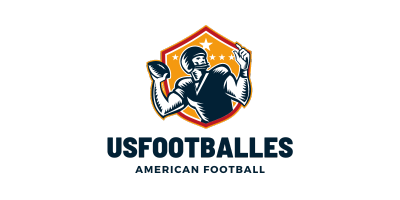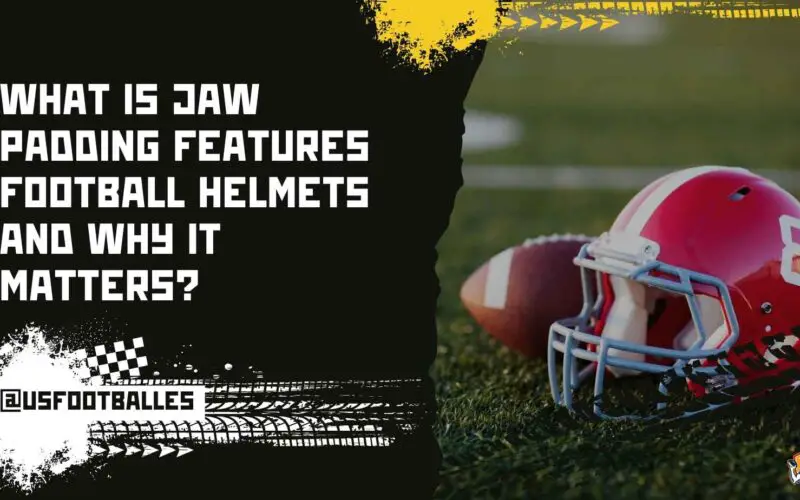Jaw padding in football helmets refers to the cushioning material around the jaw area, designed to absorb impact & reduce the risk of injury during collisions. This padding enhances player safety by providing a barrier that helps prevent concussions & jaw injuries, which are common in football. Proper jaw padding supports the helmet’s fit, ensuring it remains securely in place during play, thereby maximizing protection. Effective jaw padding is crucial for overall helmet performance, as it contributes significantly to the athlete’s safety on the field.
What are jaw padding features in football helmets & why do they matter? Discover What is jaw padding features football helmets and why it matters for player safety. Learn how these designs help absorb impact & enhance comfort!
What is Jaw Padding Features in Football Helmets?
Jaw padding features in football helmets refer to the specific padding located in the jaw area. This part is essential for player safety & comfort during gameplay. The padding absorbs & reduces impact from hits & falls. It serves as a barrier that protects players’ jaws, teeth, & other facial structures. Another thing is that jaw padding helps create a snug fit within the helmet. This ensures that the helmet stays in place during vigorous activity.
On top of that, jaw padding plays a critical role in preventing concussions. Concussions are a serious concern in contact sports like football. As players experience strong impacts, the risk of head injuries rises. Proper padding helps lessen these forces, making it crucial for all players. Without adequate jaw padding, players may suffer injuries that affect their careers & lives. For these reasons, it’s vital to understand what jaw padding features football helmets have, especially for parents, coaches, & players.
The Anatomy of a Football Helmet: Where Does Jaw Padding Fit In?
Before we fully respect the significance of jaw padding, permit us to take a moment to recognize the anatomy of a soccer helmet. Imagine a knight’s armor however tailored for the gridiron warrior. A normal soccer helmet consists of several key additives:
- Outer Shell: Made from hard polycarbonate or different durable substances, the primary defence against influences.
- Inner Liner: Cushioned with foam or air-filled pads, this deposit absorbs shock and distributes pressure calmly throughout the top.
- Face Mask: Protecting the face at the same time as allowing visibility, this metallic grillwork is iconic in football tradition.
- Chinstrap: This device secures the helmet snugly to the player’s head, preventing it from moving during play.
- Jaw Padding: Positioned across the lower part of the helmet, this padding cushions the jawline and cheeks.
Now, here’s where matters get interesting. While these elements work collectively to protect a participant, jaw padding performs a unique function. It guarantees comfort, reduces strain points, and offers an extra layer of protection for one of the most vulnerable areas of the face: the jaw.
But what makes jaw padding so special? Let’s discover.
Why Jaw Padding Matters for Player Safety
Player safety is a top priority in football. Jaw padding features in football helmets are fundamental in protecting athletes from injuries. First, these padding materials absorb shock. They reduce the impact force transferred to the jaw & skull. This quality can significantly lower the risks of severe injuries during games.
Secondly, poor-fitting helmets can lead to unnecessary injuries. Loose helmets may shift during play, exposing players to risks. Jaw pads help create a snug fit. This ensures the helmet remains in place, helping to keep the head safe from impacts.
And don’t forget, helmets are rigorously tested for safety. Organizations like the National Operating Committee on Standards for Athletic Equipment (NOCSAE) set standards. They examine the effectiveness of helmet padding, including jaw pads. Studies show that well-padded helmets reduce the likelihood of head injuries.
In addition to safety, comfort is also a concern. Players often play in challenging conditions. With the right jaw padding, they can focus on the game rather than discomfort. This contributes to overall performance.
“A proper jaw padding is crucial for reducing injuries.” – Gordon Lesch
Different Types of Jaw Padding Materials
Helmets can utilize several types of materials for jaw padding. Some of the most common include foam, gel, & air-filled padding. Each provides unique benefits to athletes. Understanding the differences is crucial when selecting a helmet.
| Type of Jaw Padding | Benefits |
|---|---|
| Foam | Lightweight, effective for shock absorption |
| Gel | Offers comfort & additional impact protection |
| Air-filled | Customizable fit, adjustable padding levels |
Foam padding is the most commonly used. It provides significant shock-absorbing qualities. It is also lightweight & long-lasting. Gel padding offers a higher level of comfort. It moulds to the shape of the jaw, enhancing fit & security. Air-filled padding can be adjusted as needed. This customizability allows for a personalized fit, crucial for athletes of different sizes.
Each type has its pros & cons. When choosing a football helmet, examining the jaw padding material is vital. This feature can have considerable effects on safety & comfort.
How to Choose the Right Jaw Padding for a Helmet
Selecting the right jaw padding is essential for both safety & comfort. Here are some steps to aid in that process:
- Examine the material type. Choose between foam, gel, or air-filled.
- Look for helmets that offer additional padding options.
- Test the fit. Ensure the helmet sits snugly on the head.
- Check for certifications from safety organizations.
When considering materials, it is essential to know the advantages of each type. As mentioned, foam is lightweight, while gel provides comfort. Air-filled can be more adjustable. Depending on the player’s needs, one may be better than the other.
Fitting also plays a substantial role in selecting a helmet. Players should ensure that the jaw padding fits correctly & snugly against the jaw. Instability can lead to injuries. Finally, ensure the helmet meets safety standards. Choosing certified helmets ensures the player receives the best protection available.
Maintaining Jaw Padding in Football Helmets
To maximize safety features, regular maintenance of jaw padding is vital. Over time, even the best materials can degrade. Coaches & players should inspect padding for wear & tear. If they notice any degradation, replacing the padding is necessary.
Cleaning jaw padding helps prolong its life. Use mild soap & water for cleaning. Avoid harsh chemicals that may damage the materials. Proper cleaning also reduces the buildup of bacteria & odours. This can enhance the comfort of wearing the helmet.
And another thing, football helmets should be stored correctly. Keep them in a dry, cool place. Extreme heat or moisture can compromise padding. Inspecting helmets before each game ensures safety standards are upheld.
| Maintenance Task | Frequency |
|---|---|
| Inspection for wear | Every game day |
| Cleaning with mild soap | Weekly |
| Replacement of padding | As needed |
The Future of Jaw Padding Technology in Football Helmets
Next-generation technology continues to improve jaw padding features in football helmets. Research focuses on new materials that provide better shock absorption & comfort. For example, companies are exploring smart materials. These materials can adjust firmness & cushioning based on impact.
Another exciting development includes 3D printing. With this tech, helmets can be custom-fitted for individual players. This helps ensure maximum protection. Innovations in design also seek to reduce weight. Lighter helmets enable better player mobility, enhancing on-field performance.
The growing awareness around concussion safety fuels these advancements. Major organizations are investing in research for safer helmet designs. As more data becomes available, manufacturers can refine jaw padding effectiveness.
In summary, the future looks promising. Better materials & designs will help protect players. This focus on safety will continue to evolve as the sport grows.
👉Related Post: Best Brand For Football Helmets 2025: Top Brands Reviews
Personal Experience with Jaw Padding in Football Helmets
I remember using a football helmet when I was younger. The jaw padding felt comfortable at first. Be that as it may, over time, I noticed it did not fit properly anymore. This affected how secure the helmet felt during play. I learned how crucial jaw padding is for safety. Without adequate jaw padding, my risk for injury increased. This experience taught me to always check helmet fit & padding. It is essential for any football player, young or old.
What is jaw padding in football helmets?
Jaw padding in football helmets refers to the cushioning material that lines the areas around the jaw section of the helmet. Its primary purpose is to provide comfort & protection to players during impacts, helping to minimize the risk of injuries to the jaw & chin area.
Why is jaw padding important in football helmets?
Jaw padding is crucial in football helmets because it absorbs shock during collisions, reduces the risk of concussions, & helps secure the helmet in place. It enhances overall fit & comfort, ensuring that players can focus on the game without being distracted by discomfort or potential injury.
How does jaw padding affect helmet safety ratings?
Jaw padding plays a significant role in helmet safety ratings. Helmets that are equipped with high-quality jaw padding are often better rated because they provide enhanced protection against impacts. Safety organizations test helmets for their ability to absorb shock & prevent head injuries, making adequate jaw padding a key factor in these evaluations.
Can jaw padding be customized in football helmets?
Yes, jaw padding can often be customized in football helmets to fit the specific needs & preferences of individual players. Many manufacturers offer different sizes & types of padding, allowing players to choose the level of comfort & protection they desire, as well as ensuring a snug fit during gameplay.
What materials are commonly used for jaw padding in football helmets?
Common materials used for jaw padding in football helmets include foam, gel, & air-filled bladders. These materials are selected for their ability to absorb & dissipate impact forces while providing comfort to the player. The right combination of materials enhances the helmet’s protective features without sacrificing player comfort.
Conclusion
Understanding what jaw padding features football helmets is key for both players & parents. This essential padding provides extra comfort & support, ensuring players stay safe while focusing on the game. Good jaw padding helps absorb impacts, reducing the risk of injuries during tough tackles. On top of that, it allows for a better fit, which is crucial for overall safety. By knowing what is jaw padding features football helmets, individuals can make smarter choices when selecting their gear. In the end, investing in helmets with quality jaw padding is a step towards keeping players protected & performing at their best.






